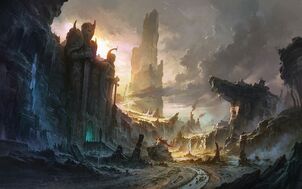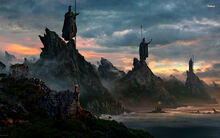
Fall of Drakonia

Drakonia as it appears in modern day
Drakonia, also called the Drakonian Peninsula, is a peninsula in southernmost Doras Edrossi. It is where the city of Drakonia was built by Aegorus Dragomárus sometime in the First Era with the aid of his dragons and his own hands. It is said that when Drakonia was finished, the city spanned across most of the north and southwest area of the peninsula. It was the ancient seat of House Dragomárus, along with the Kingdom of Drakonia, the Drakonian Republic and the Drakonian Empire.
The city existed until the end of the 6th Era when the Dragon Wars brutalized and utterly destroyed the city and the peninsula as a whole, a war that took its place as one of the deadliest wars in history. Currently, it is nothing but a ruin and a shell of it's former glory. The only remnants of Drakonia that remain are some of the towering statues beyond the Embergleam and crumbling structures that yet still stand; it is also believed that treasures and ancient knowledge are still able to be found within the still burning rubble.
Culture[]
Drakonia was known for its rich and widespread culture before the great war wiped it off the continent. Drakonians were known as advanced architects and stonemasons and very astute scholars. Their architecture was elegant yet strong enough to hold against sieges and the oldest buildings still gleamed like it was built only the day before. Many cultures who lived near or amongst the Drakonians had believed their architectural wonders to be the work of the gods, yet most believe it simply to be a form of magic.

A natural seaway leading into Drakonia's interior port. The sky can be seen burning in the background.
Drakonians are known to have exotic and beautiful racial characteristics; such as silver, silver-gold and white hair; while some uncommonly would have black or light brown hair. They had a wide range of bright eye colors, common examples being red, blue, gold or purple, the rarest colors are orange and silver. Drakonians are most commonly built quite slim and men tend to average at a height of 6 ft. Due to their culture and their religion, highborn Drakonians were often prideful and believe other cultures lesser than their own, which made diplomacy rather difficult at times.
Edrossian cultures knew Drakonians as the nickname "Celesti", which closely translates from many Edrossian dialects as "celestial ones". Sorcery was a prominent feature of Drakonians more common to the earliest eras, magic was practiced among nobility and by an ancient council known as the Strezici, which translates to "the Elders" in Drakonin. The council answered only to the ruler of Drakonia and was known as the most secretive organization in Drakonia dating back even to the Drakonian Kingdom. Little information is documented about their sorcery, as knowledge that was once written down was burned in the Dragon Wars.
The most notable feature of Drakonian culture is the taming and riding of dragons. Many powerful noble houses who resided and/or once ruled Drakonia itself, used dragons as a symbol of power, more notably House Dragomárus and Varalys. According to the Dragonlord religion, Dragons and Drakonians were made alongside one another and share blood, which may lead to these bonds. Drakonians of high birth have been known to traditionally inherit or search for dragon eggs to show their authority. House Dragomárus was known to use their flock of dragons to surpress revolts and remind disobedient lords of their liege lord's power. Even though dragon ownership became a prominent part of their culture, Drakonian nobility became chaotic and unruly. After many revolts and wars which resulted in scarred land, high death tolls and severe destruction, the Release Edict was placed in the year 5,583 BC by Imperator Tecelius Pacidis Tarnus to prevent further destruction.
The Drakonian Empire had a vast network of trade throughout Doras Edrossi, trading with many Edrossian cultures before the Dragon Wars had ended its reign, it had little trouble with trade due to resource rich land. City-states and civilizations beyond desired to acquire their craft and more notably dragonsteel. Dragonsteel was a metal created by smelting typical steel with the breath of a dragon, it never needed sharpening or repair, a mineral that many lords desired for their armies or even for themselves. Drakonian kings, emperors and high lords were known to carry dragonsteel blades as yet another symbol of power. The mineral was apparently discovered during the days of Aegorus and his heirs, in between the Age of Legends or the 1st Era. The metal is only able to be created in the flames of a dragon's breath, so acquiring dragonsteel in present day would be near impossible due to the near extinction of dragonkind.
Religion[]
Main article: The Dragonlord
The one and only well known religion in Drakonia was the worship of the Dragonlord. Some Drakonian nobles were known to have worshiped other dieties and partook in different religions, and were thus shunned. Many Drakonians were known to be quite zealous of their religion and if one did not follow, they were heretical. The religion itself is based around one main god called the Dragonlord and his dragons who were believed to have birthed the species itself and populated the lands with dragons and Drakonians as well.
Freedom of religion was practiced off and on in the Drakonian Empire but it did not suppress those who believed theirs to be superior than the other. Riots and even small civil wars have been caused over these disagreements, Dragomyr Imperators were known to have pushed the idea of the Dragonlord as the one true religion but further stated that if the law was not held in regard, punishment would ensue.
Even with the destruction of Drakonia, those who remain true to the Dragonlord remain in Ceryne and few city-states beyond, the religion is slowly fading but many still hold it in high regard in southern Doras Edrossi and further beyond.
Geography[]
Drakonia was built along the western coast of the Drakonian Peninsula, it widely spanned north and south facing the sea and sat in the western hills. The peninsula is known for its subtropical climate, with warm humid summers and mildly cold winters. The weather can range from tropical storms, to light rainfall. Drakonia was hit by numerous tropical storms during its time and Ceryne often receives storms from the peninsula due to its rather close proximity. Large storms still move across the scorched peninsula and oddly, they are much more severe as they pass through the land, often causing fire spouts from the areas that still burn.
Drakonia still burns in modern day as smoke can still be seen rising from the land. Sailors who pass the Smouldering Sea have spread rumor about an island chain south of Drakonia remaining unburnt from the Dragon Wars, although still very much abandoned and in ruin. Old maps depicting Drakonia during its reign records these islands as the Isles of Velyreos, which were home to ancient Drakonian colonies. They're often the subject of mysterious stories and legends.
Though the land still burns, much of the flames have died over the years and it is possible to traverse the scorched plains. Living there of course would be difficult and while not impossible, it would be certainly a challenging feat. There would be little resources to live off of, with basic materials such as wood, water and food being very hard to come by. Even though the war ravaged most of the land, not all of it was completely destroyed.
Flora and Fauna[]
See complete list of Drakonian wildlife here.
Very little remains in Drakonia after the Dragon Wars, plant life and animals that once lived there were destroyed significantly leaving very little behind. There is however many areas of Drakonia tucked away that have began to recover from the destruction which lie to the far south near the Isles of Velyreos.
Before the war, the land was fertile and healthy with lively creatures and plant life. Dragons were native to the land, as well as many other animal species such as Cervin, southern Dirus, Gorgons, ect. Plant life came in many varieties within the land and were famous for their healing properties. Spices such as Abbuntro, Cinder pepper, Euralaya, Icliath, Equnis, and Devil's Mint were often traded out of Drakonia.
